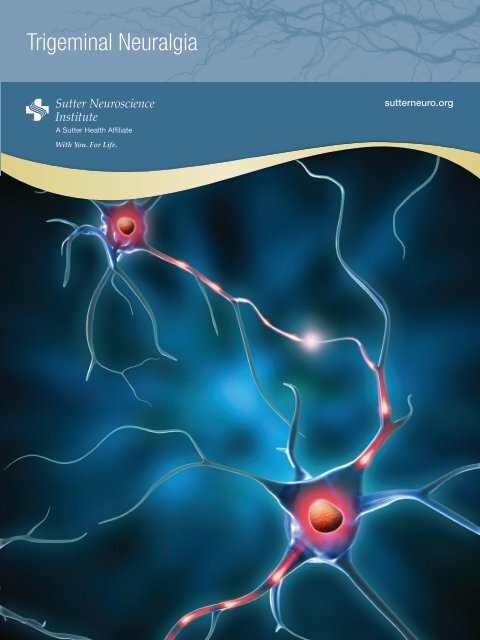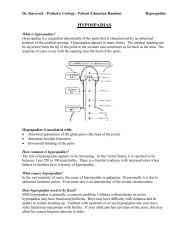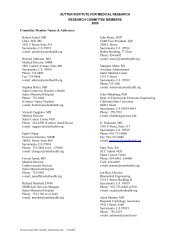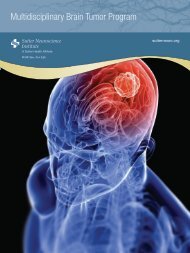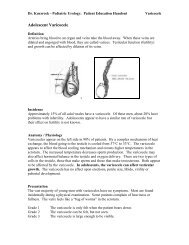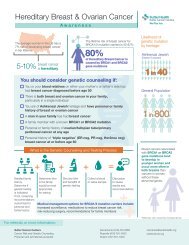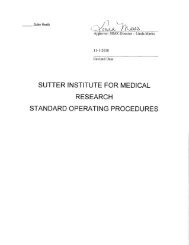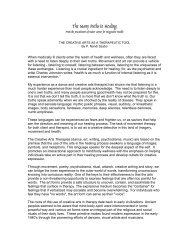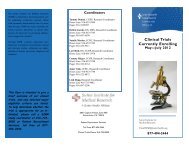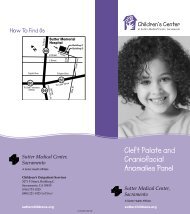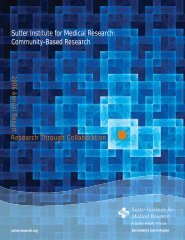Sutter Neuroscience Trigeminal Neuralgia - Sutter Health ...
Sutter Neuroscience Trigeminal Neuralgia - Sutter Health ...
Sutter Neuroscience Trigeminal Neuralgia - Sutter Health ...
You also want an ePaper? Increase the reach of your titles
YUMPU automatically turns print PDFs into web optimized ePapers that Google loves.
<strong>Trigeminal</strong> <strong>Neuralgia</strong><br />
sutterneuro.org
<strong>Trigeminal</strong> <strong>Neuralgia</strong><br />
On the leading-edge of neurosciences for the past 30 years,<br />
<strong>Sutter</strong> <strong>Neuroscience</strong> Institute provides comprehensive care for<br />
conditions of the brain, spine and central nervous system.<br />
Our team is comprised of nationally recognized specialists<br />
dedicated to the care of infants through adults by offering<br />
today’s most advanced technology, access to clinical trials<br />
and the support of a caring team of clinical experts.<br />
<strong>Trigeminal</strong> <strong>Neuralgia</strong><br />
<strong>Trigeminal</strong> neuralgia is caused by<br />
loss of insulation around the nerve<br />
fibers that make up the trigeminal<br />
nerve. The loss of insulation<br />
allows messages that should only<br />
be carried by a few nerve fibers to<br />
spread to many more nerve fibers<br />
(ephaptic transmission). This causes an excessively intense<br />
stimulation of the brain, which the brain interprets as pain.<br />
The loss of insulation is usually caused by pressure on the<br />
trigeminal nerve as it exits the brain. This pressure is typically<br />
from atherosclerosis of the arteries around the brain<br />
but in rare patients is from a tumor, vascular anomaly or<br />
multiple sclerosis.<br />
Symptoms<br />
<strong>Trigeminal</strong> neuralgia is associated with pain in a portion<br />
of the face or jaw. There is usually a “trigger zone” where<br />
touch causes very brief intense pain. There may be a series<br />
of flashes of pain lasting minutes or sometime hours.<br />
Initially the pain is very brief and there is little or no<br />
background pain between the flashes. Medical or surgical<br />
treatment usually relieves these flashes, but sometimes an<br />
underlying more constant pain emerges. The pain is often<br />
triggered by eating, talking, brushing teeth or a touch on<br />
the face.<br />
Sometimes pain is in the gum and teeth and can be<br />
confused with dental pain. It can also mimic sinus disease,<br />
temporomandibular joint disease or muscle contraction<br />
syndrome, but its very brief duration and response to<br />
Carbamazepine (Tegretol) distinguish it from these other<br />
conditions which have more sustained pain and are not<br />
relieved by Carbamazepine.<br />
Evaluation<br />
In most cases, trigeminal neuralgia is diagnosed by its<br />
characteristic symptoms and its response to Carbamazepine.<br />
Sometimes an MRI scan is needed to be sure a tumor<br />
or multiple sclerosis is not present. There are no tests<br />
which prove the diagnosis.
Treatment<br />
There are three basic kinds of treatment for trigeminal<br />
neuralgia.<br />
Medications<br />
All patients begin with medications. The most effective are<br />
usually Carbamazepine (Tegretol) or Oxcarbamazepine<br />
(Trileptal), but many seizure medications help. Narcotics<br />
are usually not very helpful. When medications are not<br />
adequate or cause too many side effects, a surgical procedure<br />
can be considered.<br />
Decompression<br />
It is possible to expose the nerve and lift an artery away,<br />
decompressing the nerve. It may be necessary to place a<br />
pad between the artery and the nerve. This is the most<br />
successful procedure for trigeminal neuralgia but requires<br />
a major craniotomy exposing the nerve in the center of the<br />
head. It is primarily used in young patients who tolerate<br />
major brain operations better than older patients. This<br />
operation relieves pain 90 percent of the time but sometimes<br />
causes imbalance, deafness, in-coordination, facial<br />
numbness or pain.<br />
Nerve Damage<br />
The other surgical choice is to damage the nerve. For<br />
more than a century, this has been effectively used to treat<br />
trigeminal neuralgia. Many techniques have been used to<br />
damage the nerve, including alcohol block, glycerol block,<br />
radiofrequency rhizotomy and balloon compression.<br />
Experience has shown the best results occur when the<br />
nerve is mildly damaged as close to the brain as possible.<br />
For the past two decades, the preferred method for this has<br />
been Gamma Knife Radiosurgery.<br />
Gamma Knife Radiosurgery has a 90 percent chance of<br />
helping pain with a 70 percent chance of being free of pain<br />
and an approximately 45 percent chance of being painfree<br />
and off medications. Pain may improve within a few<br />
days, but there is sometimes a delay of up to three months<br />
before the procedure takes effect. There may be mild<br />
numbness but it is rare for severe numbness to occur. If the<br />
degree of nerve injury is not sufficient to relieve pain, the<br />
procedure can be repeated but with a higher risk of numbness.<br />
This is an outpatient procedure and usually patients<br />
can resume normal activities the next day, although there<br />
may be a few days of soreness due to the stereotactic frame<br />
this technique requires.<br />
Our Physician Team<br />
Samuel F. Ciricillo, M.D., FACS<br />
Medical Director, Pediatric<br />
Neurosurgery<br />
Regional Medical Director,<br />
<strong>Neuroscience</strong>s, <strong>Sutter</strong> <strong>Health</strong><br />
Sacramento Sierra Region<br />
Cully Cobb, M.D.<br />
Neurosurgeon<br />
Harvey B. Wolkov, M.D., FACR, FASTRO<br />
Medical Director, Radiation<br />
Oncology<br />
Referring to <strong>Sutter</strong> <strong>Neuroscience</strong><br />
Institute<br />
We work closely with providers to make<br />
the referral process as easy as possible. To<br />
make a referral, or to learn more about our<br />
program, please call 916-454-6977 or<br />
1-888-287-2270. Physicians outside the<br />
Sacramento area may receive referral<br />
assistance from <strong>Sutter</strong> Specialty Network<br />
by calling 1-888-834-1788.
K717812P 2/12 500<br />
<strong>Sutter</strong> <strong>Neuroscience</strong> Institute<br />
Administration<br />
2800 L Street, Suite 630<br />
Sacramento, CA 95816<br />
sutterneuro.org<br />
Medical Director: Samuel F. Ciricillo, M.D., FACS<br />
Administrator: Rachael Albertson, MHA<br />
Main Line (toll-free): 1-888-287-2270<br />
Out-of-Area Referrals (toll-free): 1-888-834-1788<br />
Main E-mail: neuro@sutterhealth.org<br />
T Printed on recycled paper with soy-based inks.


